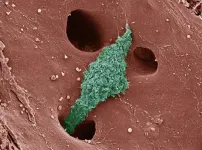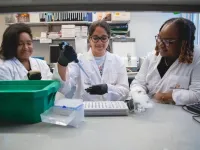(Press-News.org) Faculty members in the Department of Emergency Medicine at the University of Colorado School of Medicine have been awarded $5 million by the U.S. Department of Defense to work with partners in Ukraine on clinical and logistical challenges associated with modern large-scale combat operations and prolonged casualty care.
The overarching program — Research and Scalable Infrastructure to Improve Outcomes on the Front Lines of Ukraine by Advancing Treatment and Evaluation (RESOLUTE) — is focusing on collecting data related to antibiotic-resistant wound infections, which have substantially increased amid the military conflict.
The initial project — called the Antimicrobial Resistance Research to Improve Outcomes of Traumatic Wounds study (ARROW) — will enable future clinical trials, testing solutions that help prevent and treat wound infections and related complications.
“Ukrainians are under tremendous strain right now, so most resources and personnel have been dedicated to defending the country and providing basic medical care to injured civilians and soldiers,” says Adit Ginde, MD, MPH, professor of emergency medicine and principal investigator of the project.
Ginde worked with the CU Center for Combat Medicine and Battlefield (COMBAT) Research team to secure the research award. Corey Bills, MD, associate professor of emergency medicine, is co-lead investigator for the project.
“The ability to complete this work is important for Ukraine because it is a major issue that they have not yet been able to tackle. It also gives the U.S. military the opportunity to study war injuries during large-scale combat,” says Ginde, who also serves as principal investigator of the Airway, Trauma, Lung Injury, and Sepsis (ATLAS) research program.
Solving immediate data gaps
The conflict in Ukraine has revealed extraordinarily high rates of multidrug-resistant organisms (MRDOs), which can be difficult to treat and frequently lead to complications such as sepsis, amputations, and sometimes death.
Roman Fishchuk, MD, a clinical research leader at Central City Clinical Hospital of Ivano-Frankivsk in western Ukraine, will lead in-country efforts to collect data at three front-line hospitals and two referral centers in western Ukraine implement the study.
Wound infections resulting from trauma are among the most common contributors to illness and death among combatants and civilians in war and conflict, and MDROs have reached very high rates in Ukraine.
Currently, no systematic data collection for wound infection exists in Ukraine, so creating scalable infrastructure for that purpose is an urgent need. A key problem, Fishchuk says, is the absence of electronic health records. Some hospitals and clinics rely on hand-written documents, which cannot be used for data analysis.
“It’s not a one-day or one-person fix,” Fishchuk says. “With so many other problems in a war zone that must be solved quickly, we need RESOLUTE and ARROW so that we can make conclusions from the data that will improve patient care and outcomes.”
Fishchuk’s team will collect data and specimens over the next two years at five sites in Ukraine. The project initially will enroll up to 1,000 patients and collect data including injury and wound characteristics, molecular testing, and clinical outcomes.
“Wound infection is consistently identified as a top concern in Ukraine and the U.S. military, which is why we are moving forward on this project first,” Ginde says. “The first step is actually describing the problem in a more systematic way and then quickly pivot to clinical trials.”
Foundations for future research
The RESOLUTE program is designed to expand to include other clinical and logistical challenges, including psychological health and resuscitation, that are associated with modern large-scale combat operations. It creates paths for additional research projects and for initiating clinical trials.
“Our plan is to collect important data on wound infection, but also to create a scalable infrastructure so that we can address other areas,” Ginde says. “We have requests from government, academic, and industry partners who have solutions but not the on-the-ground presence or infrastructure that we are building. Our work in Ukraine will help us expand the program.”
“I'm grateful to our colleagues at the University of Colorado for being brave, working with us, and being so proactive. After the full-scale invasion started, most of the companies we used to work with clinical trials on stopped working in Ukraine,” Fishchuk says. “This partnership is inspiring and helps us do our job and think about research in new ways. Dr. Ginde and his team are visionaries, and they understand that this research will help patients in Ukraine and globally.”
This effort was funded under MTEC solicitation MTEC-24-01-MPAI and is funded by Combat Casualty Research Program (CCCRP) under the Department of Defense. The views and conclusions contained herein are those of the authors and should not be interpreted as necessarily representing the official policies or endorsements, either expressed or implied, of the U.S. Government.
END
DOD grants CU researchers $5 Million to study antibiotic-resistant wound infections in Ukraine
A new project funded by the U.S. Department of Defense partners emergency medicine faculty with research clinicians in Ukraine to launch a research platform for studying war-related wound infections and inform future clinical trials
2024-08-22
ELSE PRESS RELEASES FROM THIS DATE:
3D body volume scanner uses AI to help predict metabolic syndrome risk
2024-08-22
ROCHESTER, Minn. — Mayo Clinic researchers are using artificial intelligence (AI) with an advanced 3D body-volume scanner – originally developed for the clothing industry – to help doctors predict metabolic syndrome risk and severity. The combination of tools offers doctors a more precise alternative to other measures of disease risk like body mass index (BMI) and waist-to-hip ratio, according to findings published in the European Heart Journal - Digital Health.
Metabolic syndrome can lead to heart attack, stroke and other serious health issues and affects over a third of the U.S. population and a quarter of people globally. ...
Building a COMPASS to navigate future pandemics
2024-08-22
Viruses like SARS-CoV-2 don’t respect boundaries, moving between species and continents and leaving destruction as they go. Beating the next pathogen with pandemic potential means getting good at crossing borders ourselves — between fields of study, between research universities, and between scientists and the wider community.
An $18 million grant announced by the U.S. National Science Foundation (NSF) will put that goal within reach. The award brings together five universities and more than 20 researchers, academics, and public health experts to establish the Virginia Tech-led Center ...
Macrophage mix helps determine rate and fate of fatty liver disease
2024-08-22
Formerly known as nonalcoholic steatohepatitis, metabolic dysfunction-associated steatohepatitis (MASH) is an inflammatory disease characterized by liver scarring or fibrosis that progressively impairs liver function.
It is a major risk factor for cirrhosis and liver cancer. And because treatment options are limited, MASH is the second leading cause for liver transplants in the United States after cirrhosis caused by chronic hepatitis C infection.
A better understanding of the pathological processes that drive MASH is critical to creating effective treatments. In a new paper published ...
Department of Energy announces $36 million to support energy-relevant research in underrepresented regions of America
2024-08-22
WASHINGTON, D.C. - Ensuring that scientific funding goes to states and territories that have typically received smaller fractions of federal research dollars in the past, the Department of Energy (DOE) today announced $36 million in funding for 39 research projects in 19 states via the Established Program to Stimulate Competitive Research (EPSCoR). The grants connect innovative ideas from scientists at eligible institutions with leading-edge capabilities at the DOE national laboratories.
Supporting scientists while building the expertise and capabilities critical for performing leading research ...
Analysis of 1,500 climate policies reveals only a small fraction achieved significant emission reductions
2024-08-22
A new machine learning analysis has revealed the most effective climate policies out of 1,500 implemented worldwide over the last two decades. Some of the success stories – numbered at about 63 – involve rarely studied policies and unappreciated policy combinations. “Our results provide a clear yet sobering perspective on the policy effort necessary for closing the remaining emissions gap of 23 billion tons carbon dioxide (CO2) by 2023,” write the authors. To achieve the Paris Agreement’s climate targets, it is essential to know which ...
Fatty-acid derived polymers yield recyclable and highly versatile adhesives
2024-08-22
Researchers have presented a new family of polymer adhesives that offer a sustainable and recyclable alternative to conventional polymer adhesives and can be used across a wide range of applications, from industrial adhesives to surgical superglues. The new chemical approach to aLA polymerization addresses the performance and environmental challenges of traditional polymers, providing environmentally friendly adhesive solutions. Polymer adhesives are ubiquitous in modern life and are widely used in many medical, consumer, and industrial products. Given this diversity, each adhesive material is often tailored ...
Governance needed to ensure biosecurity of biological AI models
2024-08-22
Concerns over the biosecurity risks posed by artificial intelligence (AI) models in biology continue to grow. Amid this concern, Doni Bloomfield and colleagues argue, in a Policy Forum, for improved governance and pre-release safety evaluations of new models in order to mitigate potential threats. “We propose that national governments, including the United States, pass legislation and set mandatory rules that will prevent advanced biological models from substantially contributing to large-scale dangers, such as the creation of novel or enhanced pathogens ...
Spontaneous transfer of mitochondrial DNA into the nuclear genomes in the human brain over the individual’s lifespan
2024-08-22
Somatic nuclear mitochondrial DNA (Numt) insertions are mito-nuclear gene transfer events that can arise in the germline and in cancer. This study shows that Numt insertions arise spontaneously and accumulate in brain tissues during development or over the human lifespan.
#####
In your coverage, please use this URL to provide access to the freely available paper in PLOS Biology: http://journals.plos.org/plosbiology/article?id=10.1371/journal.pbio.3002723
Article Title: Somatic nuclear mitochondrial DNA insertions are prevalent in the human brain and accumulate over time in fibroblasts
Author Countries: United States
Funding: see manuscript END ...
Cancer drug could treat early-stage Alzheimer’s disease, study shows
2024-08-22
UNIVERSITY PARK, Pa. — A type of drug developed for treating cancer holds promise as a new treatment for neurodegenerative diseases such as Alzheimer’s, according to a recent study by researchers at Penn State, Stanford University and an international team of collaborators.
The researchers discovered that by blocking a specific enzyme called indoleamine-2,3-dioxygenase 1, or IDO1 for short, they could rescue memory and brain function in models that mimic Alzheimer’s disease. The findings, published today (Aug. 22) in the journal Science, suggest that IDO1 inhibitors currently ...
Drugs that improve brain metabolism could help Alzheimer’s patients
2024-08-22
Among the many ways neuroscientists think Alzheimer’s disease may strip away brain function is by disrupting the glucose metabolism needed to fuel the healthy brain. In essence, declining metabolism robs the brain of energy, impairing thinking and memory.
Against that backdrop, a team of neuroscientists at the Knight Initiative for Brain Resilience at Stanford’s Wu Tsai Neurosciences Institute have zeroed in on a critical regulator of brain metabolism known as the kynurenine pathway. They hypothesize that that the kynurenine pathway is overactivated as a result of ...
LAST 30 PRESS RELEASES:
Nanoplastics have diet-dependent impacts on digestive system health
Brain neuron death occurs throughout life and increases with age, a natural human protein drug may halt neuron death in Alzheimer’s disease
SPIE and CLP announce the recipients of the 2025 Advanced Photonics Young Innovator Award
Lessons from the Caldor Fire’s Christmas Valley ‘Miracle’
Ant societies rose by trading individual protection for collective power
Research reveals how ancient viral DNA shapes early embryonic development
A molecular gatekeeper that controls protein synthesis
New ‘cloaking device’ concept to shield sensitive tech from magnetic fields
Researchers show impact of mountain building and climate change on alpine biodiversity
Study models the transition from Neanderthals to modern humans in Europe
University of Phoenix College of Doctoral Studies releases white paper on AI-driven skilling to reduce burnout and restore worker autonomy
AIs fail at the game of visual “telephone”
The levers for a sustainable food system
Potential changes in US homelessness by ending federal support for housing first programs
Vulnerability of large language models to prompt injection when providing medical advice
Researchers develop new system for high-energy-density, long-life, multi-electron transfer bromine-based flow batteries
Ending federal support for housing first programs could increase U.S. homelessness by 5% in one year, new JAMA study finds
New research uncovers molecular ‘safety switch’ shielding cancers from immune attack
Bacteria resisting viral infection can still sink carbon to ocean floor
Younger biological age may increase depression risk in older women during COVID-19
Bharat Innovates 2026 National Basecamp Showcases India’s Most Promising Deep-Tech Ventures
Here’s what determines whether your income level rises or falls
SCIE indexation achievement: Celebrate with Space: Science & Technology
Children’s Hospital Colorado performs region’s first pediatric heart and liver dual organ transplant
Australian team discover why quantum computers have memory problems over time
What determines the fate of a T cell?
Candida auris: genetic process revealed which could be treatment target for deadly fungal disease
Groundbreaking discovery turns household plastic recycling into anti-cancer medication
Blocking a key inflammatory pathway improves liver structure and vascular function in cirrhosis, study finds
Continuous spread: Raccoon roundworm detected in nine European countries
[Press-News.org] DOD grants CU researchers $5 Million to study antibiotic-resistant wound infections in UkraineA new project funded by the U.S. Department of Defense partners emergency medicine faculty with research clinicians in Ukraine to launch a research platform for studying war-related wound infections and inform future clinical trials



